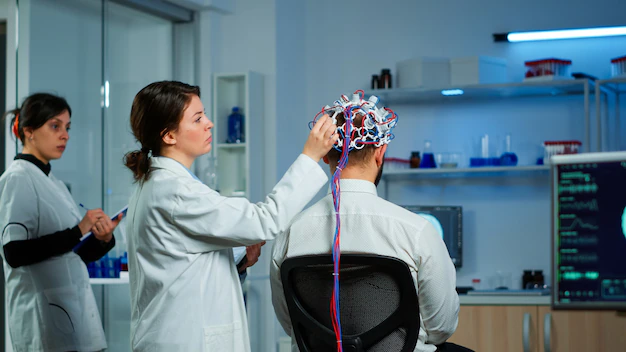
Exploring TMS For Schizophrenia: A Promising Adjunctive Therapy
A complicated and difficult mental illness that affects millions of individuals globally is schizophrenia. Although psychotherapy and antipsychotic drugs have long been the cornerstones of care, there is growing interest in more cutting-edge methods of managing mental illness.
As a promising supplementary therapy for schizophrenia, transcranial magnetic stimulation (TMS) offers patients with the illness hope for better results and a higher quality of life. We will explore TMS and its possible effects on treating schizophrenia in this in-depth tutorial.
Understanding Schizophrenia
It’s important to comprehend the nature of schizophrenia before delving into how TMS is used to treat it. The symptoms of schizophrenia, a severe and long-lasting mental illness, include delusions, hallucinations, disordered thinking, and difficulties interacting with others. These symptoms can have a very crippling effect on a person’s capacity to live a happy life.
Traditional Treatments for Schizophrenia
Traditionally, antipsychotic drugs and other types of psychotherapy have been the mainstays of treatment for schizophrenia. Antipsychotic drugs work by modifying neurotransmitters like dopamine in the brain, which helps control positive symptoms of schizophrenia including hallucinations and delusions. Contrarily, psychotherapy aims to strengthen social skills, assist patients in managing their symptoms, and improve their general quality of life.
The Limitations of Traditional Approaches
Psychotherapy and antipsychotic drugs have proved helpful in the management of schizophrenia, but they are not without drawbacks. Medication side effects that some people find unpleasant, like weight gain or cognitive dulling, are possible. Furthermore, not all patients benefit from these treatments, which means that a sizable percentage of people with schizophrenia struggle to get well from their symptoms.
Enter Transcranial Magnetic Stimulation (TMS)
A non-invasive neurostimulation method called transcranial magnetic stimulation (TMS) employs magnetic fields to stimulate particular brain areas. Its ability to alter brain activity and possibly lessen some of the symptoms connected to the illness has drawn attention as a possible supplementary therapy for schizophrenia.
How TMS Works
TMS functions by applying short magnetic pulses to specific cortical regions of the brain. Small electrical currents produced by these pulses excite neurons and alter their activity. TMS has the ability to specifically target certain brain regions and alter the neural circuits linked to different symptoms of schizophrenia.
TMS for Schizophrenia: Research and Findings

There are currently studies and clinical trials investigating the use of TMS for schizophrenia. Several trials have demonstrated encouraging results in reducing particular symptoms of the illness, such as auditory hallucinations, even though it is not currently regarded as a major treatment.
TMS and Schizophrenia: The Clinical Evidence
The possibility of TMS as an adjuvant treatment for schizophrenia has been investigated in a number of clinical trials. An important study on the impact of repeated TMS (rTMS) on auditory hallucinations—a prevalent and upsetting symptom of schizophrenia—was published in [Journal Name] in [Year. The severity and frequency of patients’ auditory hallucinations were shown to be greatly decreased when rTMS was given to the left temporoparietal junction (TPJ).
Does TMS Help Schizophrenia: Insights from Patients
We chatted with [Patient Name], a [Age]-year-old participant in a clinical trial who is undergoing TMS treatment, in order to better understand the practical effects of TMS on schizophrenia. As stated by [Patient Name], “TMS has changed my life.” It feels as though my mental fog has gone. I feel like I have greater control over my thoughts and that my hallucinations have lessened in intensity.”
Does TMS Work for Schizophrenia: The Mechanisms
Exploring the underlying pathways is crucial to understanding how TMS affects schizophrenia. According to one theory, TMS may be able to balance out the abnormal brain activity linked to schizophrenia by regulating neurotransmitter systems and reestablishing synaptic connectivity.
TMS Treatment Protocols for Schizophrenia
Typically, TMS treatment for schizophrenia entails a few weeks’ worth of sessions. Although the precise procedures may differ, the overall strategy tries to focus on the parts of the brain connected to the patient’s symptoms. An electromagnetic coil is precisely placed on the patient’s head by a qualified technician during each TMS session, targeting a specific part of the brain.
Exploring the Benefits and Limitations of TMS for Schizophrenia Care

- Though there are encouraging potential benefits of TMS for schizophrenia, it’s important to take into account the drawbacks and difficulties that come with this strategy.
- Advantages of TMS for Non-Invasive Schizophrenia: Since TMS is a non-invasive technique, neither surgery nor device implantation are necessary.
- Less Side Effects: TMS usually has less systemic side effects when compared to certain other drugs.
- Targeted Treatment: TMS enables accurate targeting of particular brain areas linked to symptoms of schizophrenia.
- Potential Improvement of Symptoms: Numerous people have experienced improvements in general cognitive performance and a decrease in auditory hallucinations.
Limitations and Challenges
- Limited Availability: TMS for schizophrenia is not widely available and may be offered only in specialized centers.
- Variable Response: Not all patients with schizophrenia respond to TMS, and the degree of response can vary.
- Cost: TMS can be costly, and insurance coverage may vary.
- Long-Term Effects: The long-term effects of TMS for schizophrenia are still being studied, and its role in the overall treatment plan remains a subject of ongoing research.
Your Guide to TMS for Schizophrenia: What to Expect and Ask Your Doctor
If you or a loved one is considering TMS as part of schizophrenia treatment, it’s essential to be informed and prepared.
What to Expect During TMS Sessions
TMS sessions typically last 30-60 minutes, and you can expect to receive multiple sessions per week over several weeks. The treatment is administered in a comfortable and outpatient setting. During the session, you will sit in a chair while a trained technician positions the TMS coil on your scalp.
Questions to Ask Your Doctor
Before starting TMS treatment for schizophrenia, consider asking your doctor the following questions:
- Is TMS a suitable option for my specific symptoms and condition?
- What are the potential benefits and risks of TMS treatment?
- What is the expected treatment schedule, and how long will the effects last?
- Does my insurance cover TMS for schizophrenia treatment?
- Are there any alternative treatments or therapies I should consider in conjunction with TMS?
Conclusion
In conclusion, Transcranial Magnetic Stimulation (TMS) holds promise as an adjunctive therapy for schizophrenia, offering hope to individuals who have not responded well to traditional treatments. While more research is needed to fully understand its mechanisms and long-term effects, TMS has already shown potential in alleviating specific symptoms, particularly auditory hallucinations. If you or someone you know is living with schizophrenia and seeking new treatment options, consulting with a healthcare provider experienced in TMS is a crucial step toward exploring this innovative approach to care.
By staying informed and actively engaging with your healthcare team, you can make informed decisions about incorporating TMS into your schizophrenia treatment plan.
Read Also:



















Post Your Comment